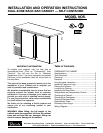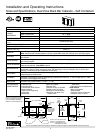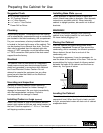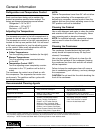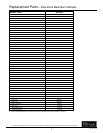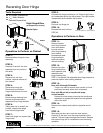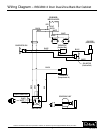
Suggested Tools
■
#2 Phillips Screwdriver.
■
10” Crescent Wrench.
■
9
/16” Allen Wrench.
■
5
/16” and
3
/8” Hex Socket.
■
Power Drill or Driver.
Plumbing
No plumbing required. Condensate from the cooling
coil is automatically evaporated through a condensate
pan located in the side condensing unit compartment.
For your convenience, a factory installed floor drain
is located in the back right corner of the cabinet. This
can be plumbed to an external floor drain. The floor
drain can be plumbed from the cabinet right side
using a
3
⁄4” NPT connection or out the bottom using
a 1” NPS connection. Both ports of the drain come
capped from the factory.
Electrical
The cabinet must be connected to a separately
fused power source (see electrical specification
plate) and grounded in accordance with National
and Local Electrical Codes. Caution: Do not
attempt to operate the equipment on any other
power source than that listed on the Electrical
Specification plate.
Uncrating and Inspection
Remove all crating material before operating.
Carefully inspect cabinet for hidden damage. If
damage is discovered, file your claim immediately
with the transportation company. Perlick is
not responsible for damage in transit.
Installing Casters or Legs (Optional)
Attach four casters or legs to the cabinet bottom;
mount rigid casters at the rear and swivel casters on
the front. Use the supplied
1
/4”- 20 x
3
/4” hex head
self-tapping machine screws.
Installing Base Plate (Optional)
Attach brackets to cabinet bottom in holes pro-
vided. Attach base plate to brackets. (See separate
instructions, provided with kit). When returning
cabinet to upright position, be careful not to bend
brackets.
WARNING!
To avoid compressor damage, after returning
cabinet to an upright position, let unit stand for
24 hours before plugging it in.
Placing the Cabinet
Push the cabinet into place using rollers when
necessary. Important: Proper air flow around the
condensing unit is necessary for efficient operation.
Never obstruct the air flow in and out of the
condensing unit.
For sanitation purposes, it may be necessary to
seal the base of the cabinet to the floor. This can be
accomplished by laying a bead of silicone sealant
between the base of the cabinet and the floor as
shown by the figure at below.
Leveling the Cabinet
When the cabinet is in place, check installation with
carpenter’s level. When level front to back and left
to right, accumulated water will drain out of cabinet
evaporator drain.
3
Perlick is committed to continuous improvement. Therefore, we reserve the right to change specifications without prior notice.
Form No. Z2304
Rev. 05.22.10
Preparing the Cabinet for Use
BEAD SILICON
SEALER (RTV)
FLOOR
CABINET



